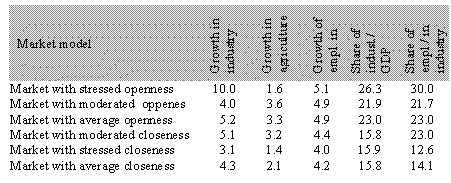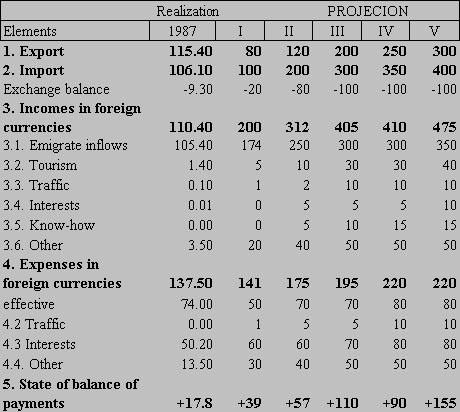
Data from the table above indicate significant problems that make a difficult economic balance, which is indispensable factor for the implementation of the model. In this aspect, except foreign currency potentials, it is also important to create a balance between export and import (trade balance & balance of payments), foreign exchange rate and foreign hard currency reserves.
In the practice of economic development we face also alternative models of an open market economy. Which of these models will be more effective, depends upon economic development, internal and external potentials, as well as application of macroeconomic policies.
For a successful implementation of this model, other experiences will be very useful. Consequences can be discouraging, because if this model is not managed properly, it will face very serious deregulations in functioning of national economy.
In this direction, international experiences of developing countries, especially of newly created countries (Lithuania, Estonia, Slovenia, Croatia) might be very useful.
Industrialization of 41 developing countries according to market model (1973-1985)

Source: Trade Policies and the Debt Crisis, World Bank, 1988
According to the analysis of developing countries, it derives that as most efficient is the model of market with stressed openness. Advantages of this model are expressed in a dynamic growth of industry, which relies on private capital and with an efficient increase of employment. This model in cases of developing countries has caused the increase of share of industry in GNP and employment. The Model with stressed openness of market has enabled Hong-Kong, South Korea and Singapore to have a dynamic development. Other models with elements of moderate openness and closeness have shown evidently smaller effects in economic development and development of industry and exports, in particular. These experiences concerning models and concepts are important as they offer solutions also in the case of Kosova. Priority will be given to the model that will successfully overcome overall development contradictions, specifics of actual development, and testified as successful in processes of integrations and globalization. Therefore, liberalization of the internal market, incorporation in world market, in technological transfers, scientific transfers must be done, as well as implementation of information technology.
6.2.1 ECONOMIC EQUILIBRIUM PROBLEMS
Establishing of overall economic equilibrium must be a permanent orientation of Kosova’s economy. The concept of an overall equilibrium is created based on:
As to how much it will be able to face unpredictable effects and advantages of open market economy, will depend upon establishing a macroeconomic stability among these indicators. A dilemma occurs: how would an economy react against the new model, and particularly in conditions of old system deformations. Another dilemma is: is the functioning of the model possible to be implemented entirely in the initial phase of development or is it to be implemented gradually. The development structure and especially problems, which are transmitted, impose the necessity of a gradual approach.
However, if some essential prerequisites are created, this model would be implemented successfully in the economy of Kosova in the case of :
The most represented positions in the balance of payments of Kosova were: export and import of goods, incomes in foreign currencies from emigree employed in foreign countries and servicing of foreign debts.
Consolidation of balance of payments and budgetary consolidation are among most important indicators during the establishing of partnership with international financial institution, as all reform programs are evaluated from the aspect of consistency of these indicators of national economy. By this is tested the functioning of market economy infrastructure and consistency of programs of economic stabilization.
As problems of public and budgetary consumption equilibrium are elaborated earlier, we deal here with the problem of the balance of payments, which for the proposed model has crucial importance.
Consolidation of balance of payments in the future will be realized in very complicated conditions. However, with a contemporary and offensive development policy and through successful realization of technological restructuring and regenerating period, this balance could be consolidated in the second or third year of transitory period. This balance must synthesize all elements of macroeconomic equilibrium and ascertain the functioning of the model of open market economy. The structure of this balance must be improved through:
The first step that must be taken in Kosova’s economy is the consolidation of the exporting economy. For realizing this activity, it will be necessary to compile special programs. In these programs, the activities, bearers and dynamics of realization of proper recommendations must be determined.

Balance of payments for transitory period in $millions
A return in former markets will be difficult, as they have undergone essential changes in recent years. Some of these markets, such as clearing market, have stopped to function many times ago. But, on the another side, creation of new markets as a result of dissolution of former Yugoslavia and the Soviet Union, has become popular. In these circumstances, it results that Kosova must establish clear strategies for stimulating of export and other forms of international cooperation. On exporting effects will depend mostly owercoming of limiting problems and creation of material frameworks for functioning of open market economy..
Essential Elements of Export Encouraging Policy:
- agribusiness
- hotels and restaurants and touristic services
- services of high professional level
In the first phase of economic recovery, it will be difficult to maintain a global equilibrium in the relation: balance of payments – exchange rate -external liquidity. In conditions of import liberalization, only an offensive export policy can overcome limitations of balance of payments.